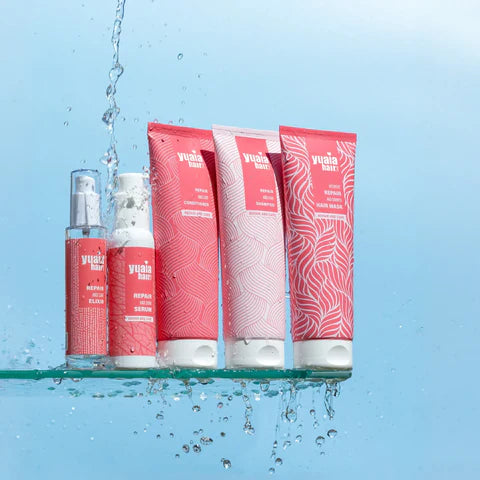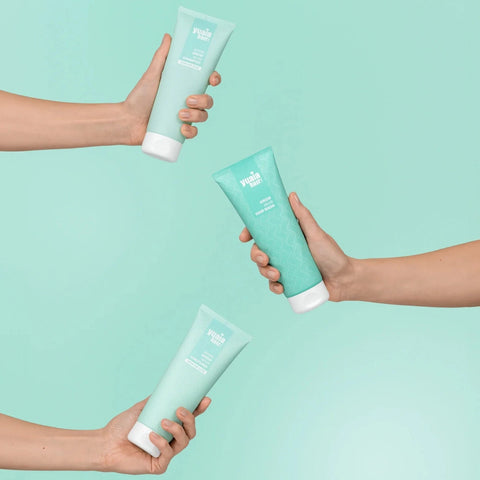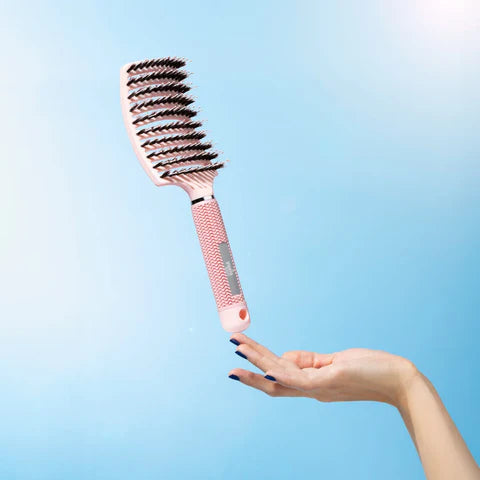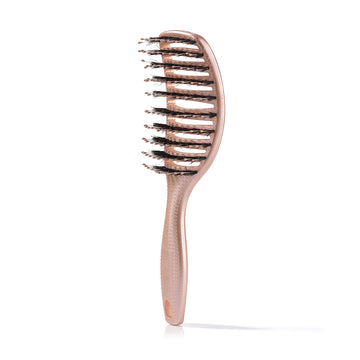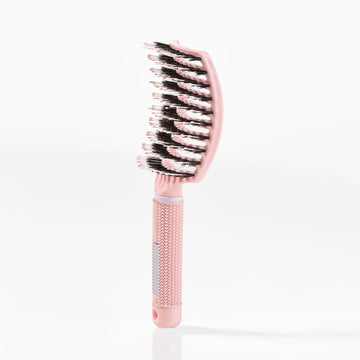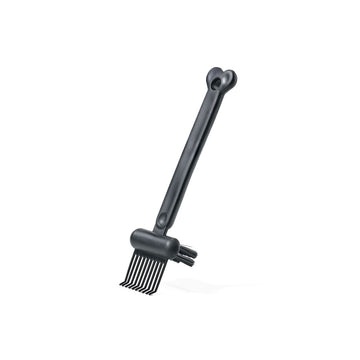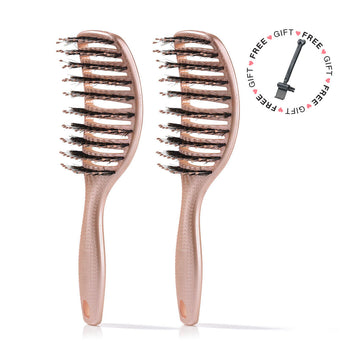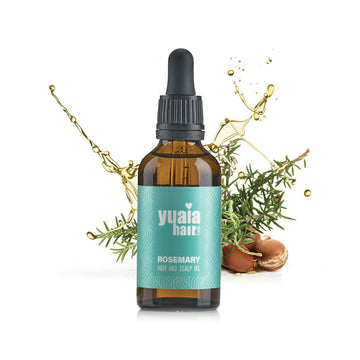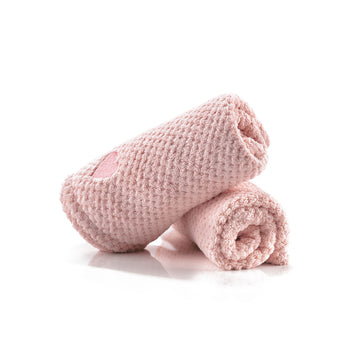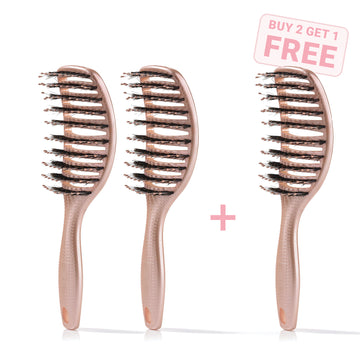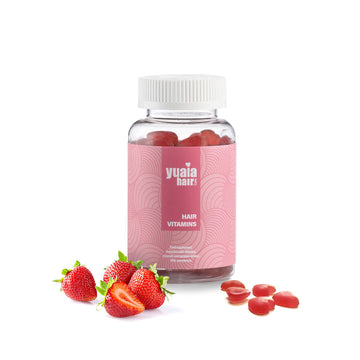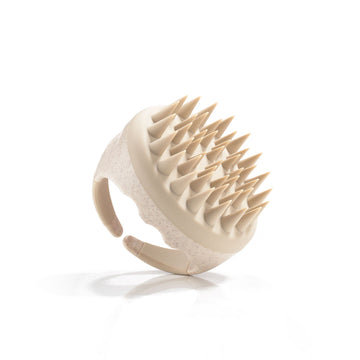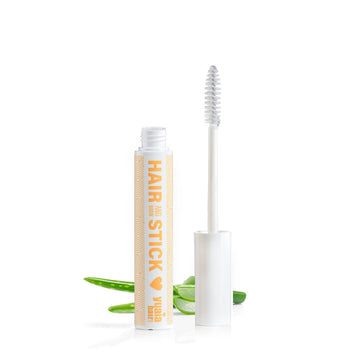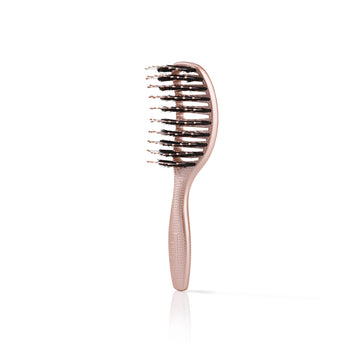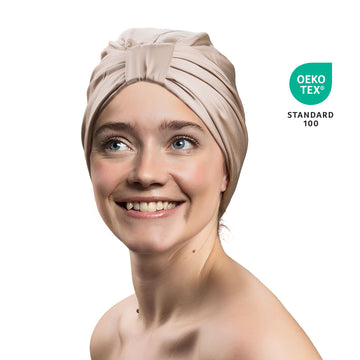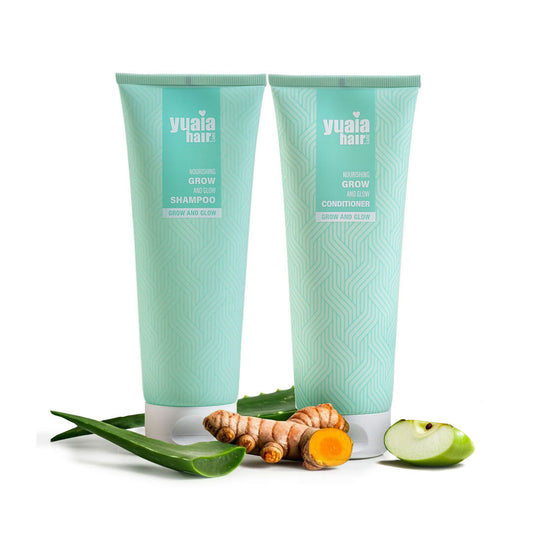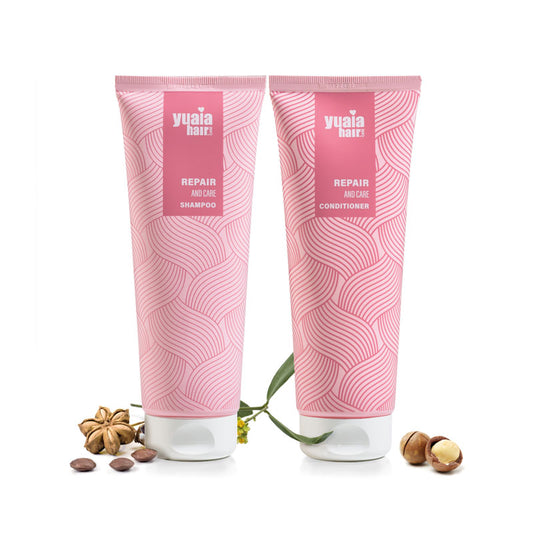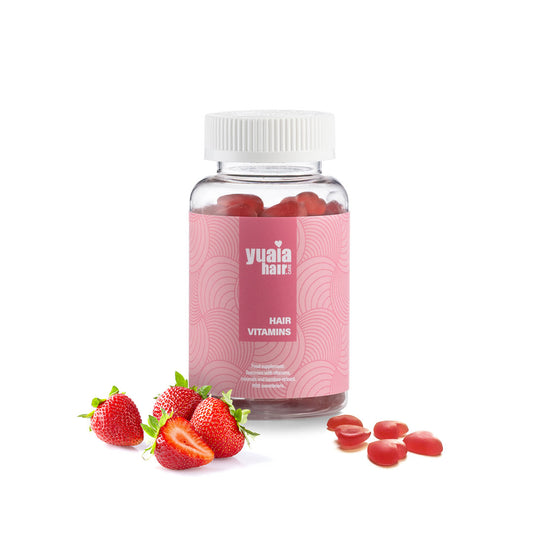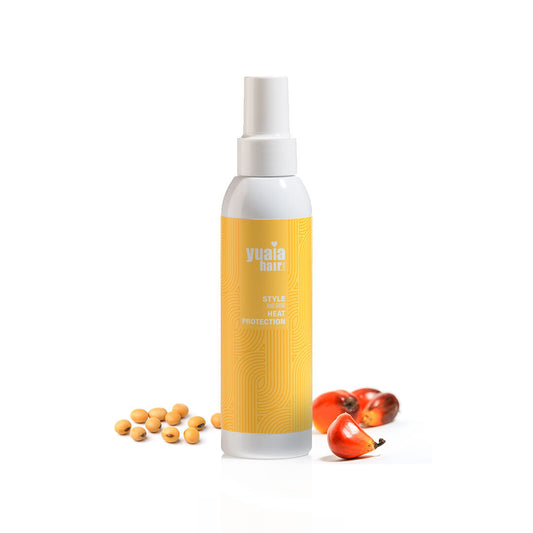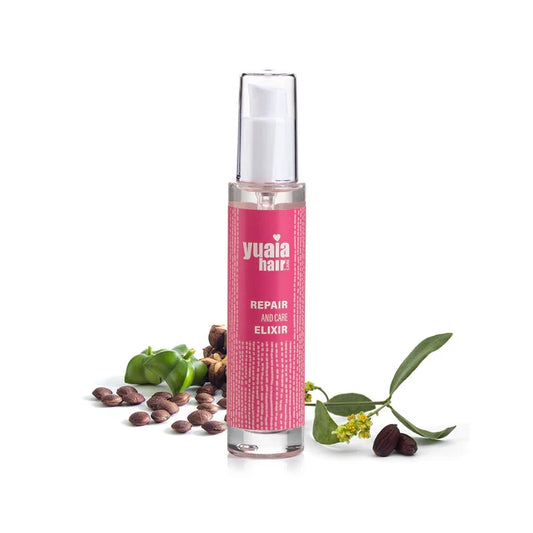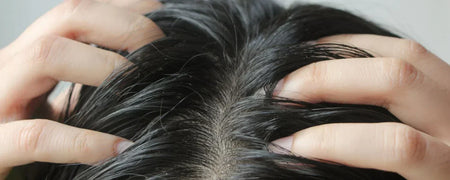
Waarom is te veel talg een probleem?
Hoewel talg essentieel is voor het behoud van een gezonde hoofdhuid en gezond haar, kan een overmatige productie verschillende problemen veroorzaken die zowel het uiterlijk als het comfort beïnvloeden.
Een van de meest opvallende effecten is een vettig uiterlijk. Overproductie van talg kan ervoor zorgen dat het haar er kort na het wassen vet, plat en onzuiver uitziet. Dit gebrek aan volume en frisheid kan frustrerend zijn, vooral als het lijkt alsof geen enkele wasbeurt de situatie verbetert.
Overtollig talg kan ook leiden tot hoofdhuidirritatie. Wanneer talg zich vermengt met zweet, dode huidcellen en resten van haarproducten, vormt het een laagje opeenhoping op de hoofdhuid. Deze ophoping kan de haarzakjes verstoppen en irritatie, schilfers en jeuk veroorzaken. Na verloop van tijd kan het zelfs de gezondheid van de hoofdhuid en de haargroei aantasten.
Een vette hoofdhuid creëert een ideale omgeving voor roos en hoofdhuidaandoeningen. Een teveel aan talg kan de groei van Malassezia gist bevorderen, wat in verband wordt gebracht met roos en seborroïsch eczeem. Deze aandoeningen kunnen aanhoudende jeuk, roodheid en schilfering veroorzaken.
Tot slot kan haaruitval een gevolg zijn van te veel talg. Chronische overproductie kan de haarzakjes verstoppen, wat kan leiden tot ontstekingen en aandoeningen zoals folliculitis. Deze problemen kunnen de haarwortels verzwakken en na verloop van tijd bijdragen tot dunner wordend haar of haaruitval.
Veelvoorkomende oorzaken van vet haar na het wassen
Zelfs na een grondige wasbeurt kan het haar soms vettig en onzuiver aanvoelen. Dit resultaat wijst vaak op specifieke onderliggende oorzaken die invloed hebben op hoe je hoofdhuid olie produceert of hoe producten en technieken op je haar inwerken. Het identificeren van deze oorzaken is de sleutel tot het bereiken van een echt verfriste en schone look.
Haar te veel wassen
Te veel haren wassen kan de natuurlijke balans van oliën op je hoofdhuid verstoren. Als je je haar te vaak wast, verdwijnt talg dat essentieel is om de hoofdhuid gehydrateerd en beschermd te houden. Als reactie hierop maken de talgklieren overuren om de verloren oliën aan te vullen, wat leidt tot een verhoogde talgproductie. Deze overcompensatie creëert een cyclus waarbij de hoofdhuid vetter wordt en je de behoefte voelt om je haar vaker te wassen. Na verloop van tijd kan dit proces ervoor zorgen dat je haar er kort na het wassen vet en plat uitziet. Je wasfrequentie aanpassen is cruciaal om deze cyclus te doorbreken en een gezonde hoofdhuidbalans te behouden.
Ongeschikte haarproducten
Het gebruik van haarverzorgingsproducten die niet afgestemd zijn op je haartype kunnen aanzienlijk bijdragen tot vettigheid na het wassen. Zware conditioners, stylinggels of producten die rijk zijn aan siliconen kunnen het haar verzwaren, waardoor het er plat en vet uitziet. Vooral siliconen creëren een laagje op de haarschacht dat olie, vuil en productresten kan vasthouden. Dit residu vermindert niet alleen het frisse, schone gevoel na het wassen, maar zorgt er ook voor dat het haar er ongewassen en dof uitziet.
Producten die bedoeld zijn om het haar te hydrateren of te herstellen zijn vaak te rijk voor van nature vet haar, waardoor het nog vetter wordt. Ook het verkeerd gebruiken van leave-in producten of het te dicht bij de hoofdhuid aanbrengen van conditioner kan het probleem verergeren. Het is belangrijk om lichte, sulfaatvrije producten te kiezen die speciaal zijn samengesteld voor jouw haartype. Regelmatig gebruik van een zuiverende shampoo kan ook helpen om de ophoping te verwijderen, je haar fris te houden en de overproductie van olie veroorzaakt door zware producten te voorkomen.
Verkeerde wastechnieken
De manier waarop je je haar wast speelt een cruciale rol in het behouden van een gezonde balans van oliën. Het onvoldoende uitspoelen van shampoo en conditioner is een van de meest gemaakte fouten, waardoor er residu achterblijft dat zich ophoopt op de hoofdhuid en het haar. Dit residu kan de haarzakjes verstoppen, het haar verzwaren en bijdragen aan een vettig uiterlijk.
Een ander veelvoorkomend probleem is het aanbrengen van conditioner op de hoofdhuid in plaats van te focussen op de middenlengtes en punten van het haar. De hoofdhuid produceert van nature talg, dus het toevoegen van extra vocht in dit gebied kan het overbelasten, waardoor het haar zwaar en vet aanvoelt. Conditioner moet spaarzaam worden gebruikt en alleen daar waar het het meest nodig is om te voorkomen dat het haar nog vetter wordt.
Ten slotte kan het gebruik van heet water tijdens het wassen de hoofdhuid van zijn natuurlijke oliën ontdoen, waardoor de talgklieren meer talg gaan produceren als compenserende reactie. Als je voor lauw water kiest, zorg je voor een gezonde hoofdhuidbalans.
Hormonale schommelingen
Hormonale veranderingen hebben een grote invloed op de talgproductie en leiden vaak tot vetter haar. Tijdens de puberteit stimuleren verhoogde androgeenspiegels de talgklieren, wat resulteert in overtollige olie op de hoofdhuid. Ook hormonale verschuivingen tijdens de menstruatie of zwangerschap kunnen de activiteit van androgenen verhogen, waardoor de talgproductie toeneemt. Deze schommelingen zijn een natuurlijke reactie op de veranderende hormoonspiegels van het lichaam, maar kunnen ervoor zorgen dat het haar vet aanvoelt ondanks regelmatig wassen. Hormonale onevenwichtigheden, zoals die geassocieerd worden met het polycysteus ovarium syndroom (PCOS) of schildklieraandoeningen, kunnen dit probleem verergeren. Door deze veranderingen aan te pakken met de juiste haarverzorging of door een professional te raadplegen, kun je vettigheid effectief aanpakken.
Dieet en levensstijl
Dieet- en leefstijlkeuzes spelen een belangrijke rol bij de gezondheid van de hoofdhuid en de talgproductie. Een dieet met veel ongezonde vetten of koolhydraten kan bijdragen aan een verhoogde vettigheid. Voedingsmiddelen met een hoog glycemgehalte, zoals suikerhoudende snacks en geraffineerde koolhydraten, veroorzaken snelle pieken in de bloedsuikerspiegel, wat leidt tot een verhoogde insulinespiegel. Deze stijging in insuline stimuleert androgene hormonen, die op hun beurt de talgproductie stimuleren, waardoor het haar vetter wordt.
Stress en slaapgebrek zijn ook belangrijke factoren. Beide verstoren de hormonale balans, wat kan leiden tot overactieve talgklieren. Een evenwichtig dieet, regelmatige lichaamsbeweging en stressbeheersingstechnieken kunnen helpen om de talgspiegel te reguleren en gezonder haar te behouden.
Hoe voorkom je vet haar - zelfs nadat je het gewassen hebt?
Het vinden van de juiste wasfrequentie is de sleutel tot het beheersen van vet haar. Als je je haar te vaak wast, verdwijnen de natuurlijke oliën, waardoor de hoofdhuid gaat compenseren door meer talg te produceren, wat leidt tot een voortdurende cyclus van vettigheid. Om dit patroon te doorbreken, is het belangrijk om overwassen te vermijden en de hoofdhuid de tijd te geven om de olieproductie op natuurlijke wijze te reguleren.
Het is essentieel om een evenwichtige wasroutine te ontwikkelen die is afgestemd op je haartype en levensstijl. Vet haar moet misschien om de dag worden gewassen, terwijl droog of krullend haar vaak baat heeft bij minder vaak wassen, ongeveer 2 tot 3 keer per week. Observeren hoe je haar reageert op verschillende intervallen kan je helpen een schema op te stellen dat het haar schoon houdt zonder de hoofdhuid te veel te belasten. Het gebruik van de juiste producten voor jouw haartype kan deze routine verder ondersteunen en zorgen voor een frisse en gezonde look zonder de overmatige vettigheid die overwassen kan veroorzaken.
Gebruik de juiste haarproducten
Het kiezen van de juiste haarproducten is essentieel om vettigheid onder controle te houden. Kies voor lichtgewicht, niet-comedogene shampoos en conditioners die speciaal ontwikkeld zijn voor vet haar. Deze producten bevatten geen zware ingrediënten zoals siliconen die het haar kunnen verzwaren of residu achterlaten, waardoor de vettigheid verergert.
Het correct aanbrengen van conditioner is net zo belangrijk. Richt je altijd op de lengten en punten van je haar, waar hydratatie het meest nodig is, en vermijd de hoofdhuid. Het aanbrengen van conditioner op de hoofdhuid kan deze overladen met vocht, waardoor overtollige talgproductie wordt gestimuleerd en het haar vet lijkt. Door je producten en technieken op maat te maken, zorg je voor een frisse, gebalanceerde look.
Grondig spoelen
Ervoor zorgen dat alle shampoo- en conditionerresten volledig worden uitgespoeld is essentieel voor gezond haar. Achtergebleven producten kunnen leiden tot irritatie van de hoofdhuid, dofheid en vettigheid, waardoor het haar moeilijk te stylen is. Het is aan te raden om je haar enkele minuten met lauw water uit te spoelen om er zeker van te zijn dat alle producten verwijderd zijn. Afspoelen met koel water kan helpen om de haarschubben te sluiten, waardoor het haar meer glans en gladheid krijgt.
Spoelen met lauw water
Vermijd het gebruik van heet water, omdat dit de natuurlijke oliën van de hoofdhuid verwijdert, waardoor de talgproductie toeneemt. Kies in plaats daarvan voor lauw of koel water tijdens het spoelen. Dit helpt de natuurlijke oliebalans van de hoofdhuid in stand te houden, voorkomt uitdroging en kan de glans van het haar verbeteren, waardoor het er gezonder en beter handelbaar uitziet.
Het stressniveau onder controle houden
Stress kan de hormoonspiegels verstoren, wat leidt tot een verhoogde talgproductie en vetter haar. Het toepassen van stressbeperkende technieken zoals meditatie, regelmatige lichaamsbeweging en voldoende slaap kunnen helpen bij het reguleren van de hormoonbalans. Deze praktijken zijn niet alleen goed voor je algehele welzijn, maar ondersteunen ook een gezondere hoofdhuid en verminderen overtollige talgproductie.
Bescherm je haar tegen omgevingsfactoren
Bescherm je haar tegen vervuiling door hoeden te dragen of beschermende kapsels te gebruiken om de blootstelling aan schadelijke elementen te verminderen. Om vochtigheid tegen te gaan, gebruik je antikroesproducten die een barrière vormen tegen overtollig vocht. Kies daarnaast voor kapsels die de reactie van het haar op vochtigheid helpen beheren, zodat het glad blijft en minder snel vet wordt.
Uitgebalanceerd dieet
Een uitgebalanceerd dieet dat rijk is aan essentiële voedingsstoffen speelt een belangrijke rol bij het behouden van normaal haar. Magere proteïnen, fruit, groenten, volle granen en gezonde vetten zorgen voor de vitaminen en mineralen die nodig zijn voor normaal haar. Voedingsstoffen zoals biotine, ijzer, zink en vitamine A en C zijn bijzonder heilzaam. Omgekeerd kunnen diëten met veel bewerkte voedingsmiddelen en suikers een negatieve invloed hebben op de haarkwaliteit.
Wanneer moet je een professional raadplegen voor vet haar?
Af en toe last hebben van vet haar is normaal en vaak beheersbaar met de juiste haarverzorgingsroutines. Sommige situaties rechtvaardigen echter het raadplegen van een dermatoloog of gezondheidsdeskundige:
- Aanhoudende vettigheid ondanks de juiste verzorging: Als je haar overmatig vet blijft, zelfs nadat je de wasfrequentie hebt aangepast, de juiste producten hebt gebruikt en de aanbevolen haarverzorgingspraktijken hebt gevolgd, kan dit wijzen op een onderliggend probleem dat professioneel moet worden onderzocht.
- Begeleidende problemen met de hoofdhuid: De aanwezigheid van symptomen zoals jeuk, roodheid, schilfering of de ontwikkeling van schilferende plekken naast vet haar kunnen wijzen op aandoeningen zoals seborroïsch eczeem of psoriasis van de hoofdhuid. Een dermatoloog kan een nauwkeurige diagnose stellen en effectieve behandelingen aanbevelen.
- Haaruitval of dunner wordend haar: Merkbaar haarverlies of dunner worden in combinatie met een vette hoofdhuid kan een teken zijn van een follikelontsteking of andere hoofdhuidaandoeningen. Vroegtijdig overleg met een professional kan helpen om het probleem aan te pakken en verder haarverlies te voorkomen.
In deze gevallen is het raadzaam om een dermatoloog te raadplegen, omdat die de gezondheid van je hoofdhuid kan beoordelen, onderliggende aandoeningen kan vaststellen en een persoonlijk behandelplan kan opstellen om overmatige vettigheid effectief te bestrijden.
Een nieuwe start voor je haar
Vet haar na het wassen kan frustrerend zijn, maar inzicht in de oorzaken en effectieve oplossingen kunnen het verschil maken. Van het aanpassen van je wasgewoonten tot het kiezen van de juiste producten en het behouden van een evenwichtig dieet, kleine veranderingen kunnen leiden tot grote verbeteringen. Als je last blijft houden van vettigheid, aarzel dan niet om een professional te raadplegen om mogelijke onderliggende problemen op te sporen. Met de juiste aanpak kun je elke dag genieten van schoon, gezond en levendig haar!
 2-4 dagen levering
2-4 dagen levering
 100.000+ tevreden klanten
100.000+ tevreden klanten
 Tevredenheidsgarantie
Tevredenheidsgarantie


